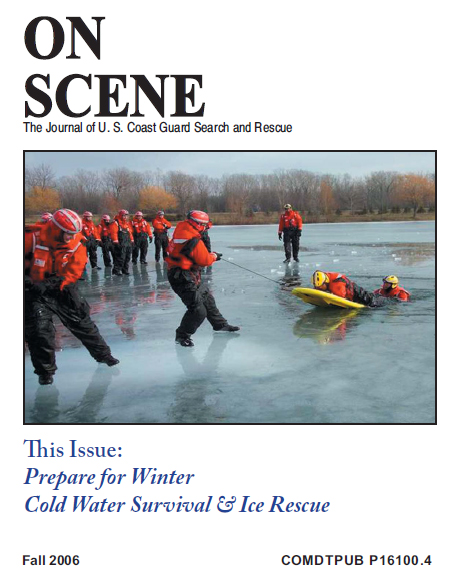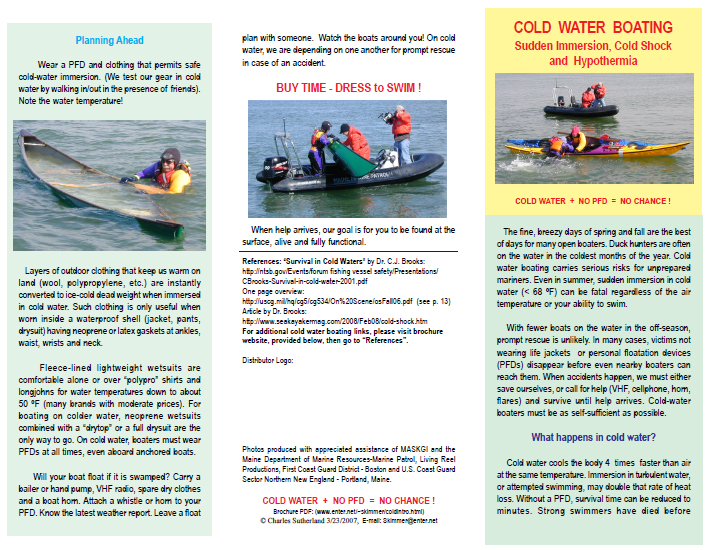|
Boating Safety Awareness
  Four Stages of Cold-Water Immersion
Four Stages of Cold-Water Immersion COLD WATER + NO PFD = NO CHANCE Why I Kayak
By John Rako
In these times, when our typical day is fast paced, driven by to-do lists and deadlines, many of us yearn to make the whirlwind stop, and to find a safe harbor. Others, it seems, seek distraction with adventure or excitement.
It’s for all these reasons that I paddle a kayak. A self-propelled boat is quiet and connects me with the water it rides on. It heightens all my senses because it doesn’t interfere with any of them the way automobiles and power boats do. While kayaking, I can see all around me with no direction obstructed. I feel the wind on my face and the waves beneath me. I hear the water, the birds and even the sounds of a city more clearly. I can smell the fresh air and, sometimes, the not-so-fresh air. And I can taste adventure, even close to town, connecting with my inner Huck Finn.
On rivers I must be focused and constantly aware, engaged in a continuous process of planning my next move. On quiet lakes I glide in silence, getting closer to wildlife than I could in any other way. And on the ocean I have a sense of freedom that is rare in modern life.
My boat can carry a few extras, luxuries that I couldn’t carry as easily on a hike. I’m seldom bothered by insects and I travel with less effort than when walking. In fact, when I’m on a river, I can travel with no effort at all, if I choose to.
My friends and I have had some well planned adventures. But some adventures have been unplanned and even unwelcome. It’s a little late to think about the importance of carrying a bit of duct tape after cracking your hull or breaking your paddle. It’s too late to consider the importance of traveling in a group after you’ve capsized, alone, on a lake or bay.
I was always well prepared on whitewater rivers because I perceived them as dangerous. Lakes – not so much. But lakes, especially large ones, can kick up some pretty big waves or carry a lot of boat traffic. I’ve had the unnerving experience of being blown across a lake, out of my boat and out of control wishing I had invited a companion who could have helped me.
The ocean seems like a very big lake. But I had to deal with surf when returning at the end of the day in addition to learning to navigate, use a radio and read tide and current tables and more. Having friends along for companionship and safety is even more important here than on lakes, of course.
More challenging than that are our harbors, where craft of every size and description co-exist. Even in a city, the water is a peaceful place to be and it’s easy to forget the consequences of being in an environment with a wide variety of craft, many of which weigh more than 100,000 of you in your little boat. Having skill, knowledge and preparation in a harbor environment is more important than in most any other place I paddle.
If all that seems intimidating, keep in mind that the beautiful thing about paddling a kayak is that I get to choose my adventure and my stress level and I get to tailor where I travel according to my knowledge and skills. So you won’t often find me in a congested harbor or on a marathon ocean voyage. I’m happy enough in my comfort zone on intermediate whitewater or exploring the coves and inlets of a bay that are only accessible with a small, light boat.
John Rako has been a canoe and kayak instructor for over three decades and is a partner in RiverGrizzly LLC, a photo/video production company with an emphasis on training and documentary work.
|